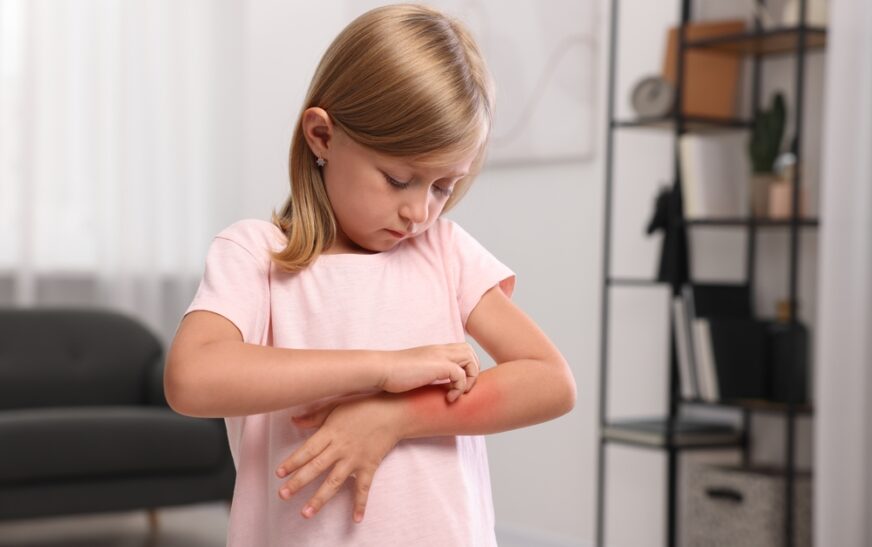Blanching rash in children is a common dermatological concern that often causes anxiety among parents and caregivers. This condition, which manifests as a rash that turns white or pale when pressed, can be an indicator of various underlying health issues.
This article will provide a comprehensive guide for parents, healthcare providers, and anyone involved in pediatric care.
Participate in our Dermatology Clinical Trials in Michigan to discover potential treatment options
Understanding Blanching Rash in Children
Blanching rash in children is a type of rash that, when pressed, turns white or lightens in color, only to return to its original appearance once the pressure is released. This blanching effect occurs due to the temporary displacement of blood from the affected area. While the presence of a blanching rash might seem alarming, it is not always indicative of a serious underlying condition. However, its occurrence warrants careful evaluation to determine the exact cause and appropriate management.
Uncovering the Roots: Recognize the Causes of Blanching Rash in Children
Blanching rash in children can result from a variety of causes, ranging from benign conditions to more serious underlying health issues. Below are the most common causes of the condition:
- Viral Infections: Viral infections such as roseola, hand-foot-and-mouth disease, and measles often cause blanching rashes in children. These rashes typically appear as part of the body’s immune response to the infection and are usually accompanied by other symptoms such as fever, sore throat, and malaise.
- Bacterial Infections: Bacterial infections, including scarlet fever and strep throat, can also lead to this condition. These rashes are often more severe and may be associated with high fever, swollen lymph nodes, and a sore throat.
- Allergic Reactions: Allergic reactions to foods, medications, or environmental allergens can cause blanching rashes. Urticaria, or hives, is a common allergic reaction that manifests as a blanching rash and is often accompanied by itching and swelling.
- Heat Rash (Miliaria): Heat rash, also known as prickly heat, is a common cause of blanching rash in children, particularly in hot and humid climates. This condition occurs when sweat ducts become blocked, leading to the appearance of small, red, and itchy bumps that blanch when pressed.
- Autoimmune Conditions: Autoimmune conditions such as lupus and juvenile dermatomyositis can cause blanching rashes in children. These rashes are often persistent and may be accompanied by other symptoms such as joint pain, muscle weakness, and fatigue.
- Vasculitis: Vasculitis, an inflammation of the blood vessels, can lead to blanching rashes in children. This condition may result from an underlying autoimmune disorder or an infection and requires prompt medical attention due to its potential severity.
- Medication Reactions: Certain medications can cause drug-induced rashes that blanch when pressed. These rashes may be a sign of a mild reaction, or in some cases, they could indicate a more severe condition such as Stevens-Johnson syndrome.
Read more: Blanching Rash Causes in Children
Symptoms of Blanching Rash in Children
The symptoms of blanching rash in children can vary depending on the underlying cause. However, following are some common symptoms associated with this condition:
- Red or Pink Rash: The most noticeable symptom is the appearance of a red or pink rash that turns white or lightens when pressed. This rash may be localized to one area or spread across multiple areas of the body.
- Itching or Irritation: Blanching rashes are often accompanied by itching, which can be mild to severe. In some cases, the rash may also cause a burning sensation or irritation.
- Fever: If the blanching rash is caused by an infection, it is often accompanied by a fever. The severity of the fever can vary depending on the nature of the infection.
- Swelling: In cases where the rash is due to an allergic reaction or an autoimmune condition, swelling of the affected area may occur. This swelling can cause discomfort and may be a sign of a more serious allergic response.
- Fatigue and Malaise: Children with a blanching rash may also experience general fatigue and malaise, particularly if the rash is associated with a systemic infection or autoimmune disorder.
- Joint Pain and Muscle Weakness: In cases where the rash is related to an autoimmune condition, symptoms such as joint pain and muscle weakness may also be present.
Are you dealing with any of these symptoms Consult with Board Certified Dermatologist to gain access to novel therapeutics while contributing to the advancement of medical science.
Impacts on Health
While blanching rash in children is not always a cause for concern, its presence can have several impacts on a child’s health, particularly if the underlying cause is not promptly addressed.
- Infection Risk: If the blanching rash is caused by a bacterial or viral infection, there is a risk of the infection spreading or worsening if not treated appropriately. This can lead to more severe health complications, including pneumonia, sepsis, or meningitis.
- Allergic Reactions: Allergic reactions that cause blanching rashes can range from mild to severe. In some cases, an allergic reaction can escalate to anaphylaxis, a life-threatening condition that requires immediate medical intervention.
- Chronic Conditions: Blanching rashes caused by autoimmune conditions or chronic infections may persist for extended periods, leading to ongoing discomfort and potential complications such as organ damage or impaired growth and development.
- Psychological Impact: The presence of a visible rash, especially if it is persistent or widespread, can cause psychological distress for both the child and their parents. This can lead to anxiety, social withdrawal, and a decreased quality of life.
Diagnosis of Blanching Rash in Children
The diagnosis of blanching rash in children typically involves a thorough medical history and physical examination. Healthcare providers may also order additional tests to determine the underlying cause, including:
- Blood Tests: Blood tests can help identify infections, autoimmune markers, and other conditions that may be causing the rash.
- Skin Biopsy: In some cases, a skin biopsy may be performed to examine the rash more closely and rule out other skin conditions.
- Allergy Testing: If an allergic reaction is suspected, allergy testing may be conducted to identify specific allergens.
- Imaging Studies: Imaging studies such as X-rays or ultrasounds may be used to assess any underlying conditions that could be contributing to the rash.
Treatment of Blanching Rash in Children
The treatment of blanching rash in children depends on the underlying cause and the severity of the symptoms.
Common treatment options include:
- Medications: Depending on the cause, medications may be prescribed to manage the rash. For example, antibiotics may be used to treat bacterial infections, while antihistamines can help alleviate allergic reactions. Corticosteroids may be prescribed for autoimmune conditions or severe inflammation.
- Topical Treatments: Topical creams or ointments may be recommended to soothe the skin and reduce itching or irritation. These may include moisturizing creams, corticosteroid creams, or antibiotic ointments.
- Hydration and Rest: Ensuring the child stays hydrated and gets plenty of rest is crucial, especially if the rash is associated with an infection or fever.
- Avoidance of Triggers: If the rash is due to an allergic reaction, identifying and avoiding the trigger is essential. This may involve dietary changes, avoiding certain medications, or modifying the child’s environment to reduce exposure to allergens.
- Monitoring and Follow-Up: Regular monitoring and follow-up appointments with a healthcare provider are important to ensure the rash is improving and to address any potential complications.
When to Seek Medical Attention
While many cases of blanching rash in children are benign and resolve on their own, it is important to seek medical attention if the rash is accompanied by any of the following symptoms:
- High fever
- Difficulty breathing
- Swelling of the face or throat
- Persistent or worsening symptoms
- Signs of a serious infection, such as severe pain, redness, or warmth around the rash
- Any signs of anaphylaxis, such as difficulty swallowing, chest tightness, or dizziness
Conclusion
Blanching rash in children is a condition that can have various causes, ranging from mild to severe. Understanding the potential causes, symptoms, and treatment options is essential for effective management. While many cases are self-limiting, others may require prompt medical intervention to prevent complications. By staying informed and vigilant, parents and caregivers can ensure the well-being of their children and address any concerns related to blanching rashes promptly.
Feel free to submit more guest posts through Links Building Servcies - Best Prices. Buy Author Account / 1$ Guest Post Here





















